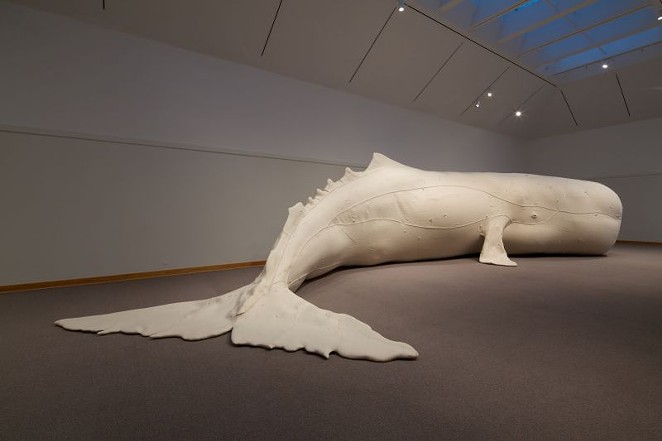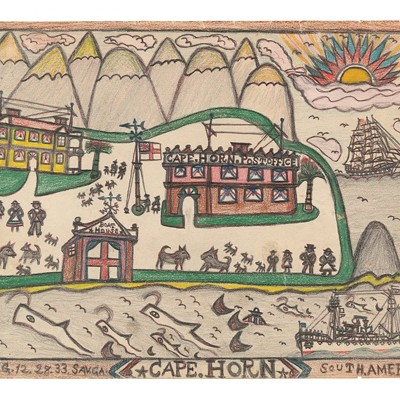This fall, the Telfair pays homage to a literary classic with an inspired contemporary exhibition.
For nearly two centuries, Herman Melville’s “Moby Dick” has been held up as an exemplary story of the struggle between good and evil. The metaphorical whale has come to mean various things to many people, and because of that ingrained experience, it endures.
“Summon the Sea! Contemporary Artists and Moby Dick,” on view now at the Jepson Center for the Arts, examines the work of six artists and their responses to the canonical whale.
Curator of Modern and Contemporary Art Rachel Reese was largely influenced by the work of Tristin Lowe, whose 52-foot installation “Mocha Dick” is now on view.
Reese met Lowe over a decade ago in Philadelphia, when she worked at the gallery where he was represented, and was inspired by “Mocha Dick.”
“When I started this job, I think the whale was one of the first things I had proposed to bring here,” remembers Reese. “Four years later, the whale is here. When the opportunity presented itself to build a larger show around this work and build it into a group show, that’s the landing point for where you see it today.”
“Mocha Dick,” completed in 2009, is inspired by a real-life whale who was an inspiration to Melville while writing his novel. Lowe created the sculpture, which clocks in at 800 pounds and 9,000 square feet of felt, with industrial quarter-inch felt.
“It’s wool, really. You can see all the matter on it when you get up close,” says Lowe. “This is stuff that would normally be on the wool from the sheep; they use an acid process to get rid of all that. I’d started working on some felt before this and always loved that history and everything. It’s an interesting material, too; it’s made differently. Some think of it as the oldest fabric.”
The whale’s felt skin works a bit like a wetsuit, with prosthetics and buttressing inside to keep its shape and a 60-foot zipper to keep it shut.
“I’d done some earlier work with inflatables, but I didn’t want to use that method [with ‘Mocha Dick’] because it almost has a cartoon plastic toy feel to it, which is great for the earlier work, but I didn’t want this work to have it,” says Lowe. “It’s actually filled with air.”
The use of white felted wool is a very intentional choice based on historical inspiration.
“Mocha Dick was the name given to a white-as-wool sperm whale spotted in the 19th century off the coast of Chile in the Mocha Islands,” explains Reese. “Jeremiah Reynolds published this account in the Knickerbocker Journal in 1839, where he describes this whale he calls Mocha Dick: it’s white as wool, it’s covered in battle scars, he’s got barnacles on his head and body, and that account was read by Melville and sort of folded into ‘Moby Dick’ as well.”
“Along with this other story of the Essex,” adds Lowe. “That was a real whaling ship sunk by a full-size sperm whale. Those stories all weave together, and Melville’s own whaling experience for a short period.”
The other artists in the exhibition—Corey Arnold, Guy Ben-Ner, Patty Chang, Allan Sekula, and Frank Stella—have also responded to “Moby Dick” and its allegorical possibilities.
“[Patty Chang] talks in her artist statement about ‘Moby Dick’ as a great allegory for capitalism, the history of whaling, talking about human greed, the growth of capitalism, the quest for petroleum leading to our contemporary greed for petroleum and fossil fuels—there’s a lineage there,” explains Reese.
“That was in early Jeremiah Reynolds stuff—talking about a concern that they were already seeing the commodification of the natural world around us, being exploited for purposes, so he was in that early naturalist kind of way,” says Lowe. “There was a really great short story, ‘Bartleby the Scrivener,’ that’s all about stocks and bonds. I even think that ‘Moby Dick’ is really about that, too. These [ships] are floating factories that go out for years, and everybody on the ship has a share in what they brought.”
“Think about the time period, the connection between whaling and slavery,” adds Reese. “Really wild stories to be dragged out from both of those, in terms of how our society is built today in America.”





























